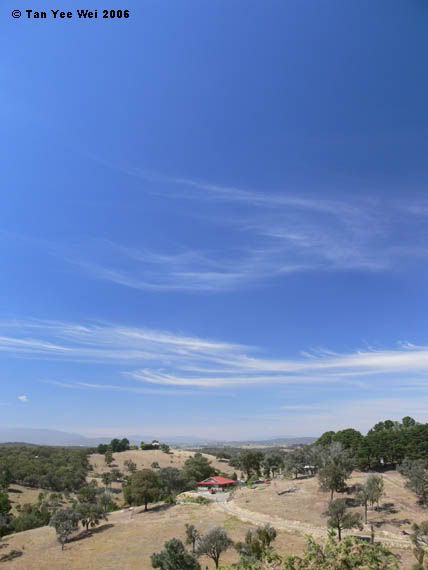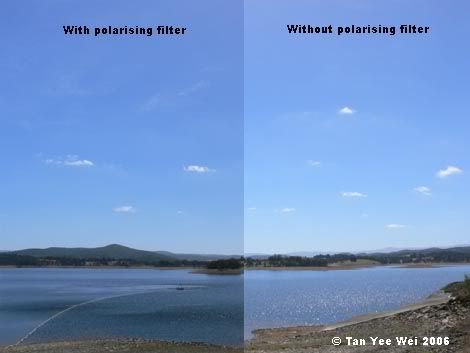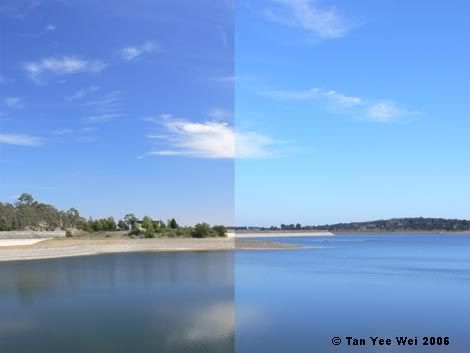Damn dams (alliteration alert!)
Today’s little trip to a faraway land did not yield much. I had initially planned to go to a winery region in the vicinity of Yarra Glen, but when I flipped through the street directory, I noticed an interesting feature near Yarra Glen- a huge body of water marked “Sugarloaf Water Reservoir”.
A rather large area near the dam wall is available to the public, with toilets, barbecue pits and the usual park-like amenities.
Since I’m a sucker for dams, I decided to go to the reservoir instead.
Why I am a sucker for dams:
Why dams tend to disappoint:

Find the telephone line
Conjecture 1: Wherever there is a beautiful scene, God or the local city/town/district council (whoever comes first) will stretch ONE strand of communication cable across the scene.
*Resizing of the image has made the line disappear from sight.
So it was quite a dull day. The sky was cooperative though, despite the bleary and overcast morning. It was more of toying with the polarising filter than really taking any cool photos. There are no remarkable photos and I’m slightly annoyed. Let’s not even talk about the petrol cost for the 110 km covered using a 260bhp (I did not use them all) 4 litre V6 power plant.
Let’s go on to the magic of polarised light. I still have yet to find a satisfactory resource to properly understand from first principles polarising filters’ effects. So it’s still considered magic at the moment.
It should be noted that polarising filters consists 2 parts: the screw thread which screws (obviously) onto the camera lens, and the filter assembly itself which can be rotated freely. AutoCAD drawings later.

Saturation and brightness difference (between 2 orthogonal polarisation angles) is greatest when the camera is pointed at a direction perpendicular to the sun.
When the camera is pointed towards or away from the sun, the effect of rotating the polarising filter is negligible.


The amount of sunlight and sky colour reflected off the water can also be moderated
Personal
A rather large area near the dam wall is available to the public, with toilets, barbecue pits and the usual park-like amenities.
Since I’m a sucker for dams, I decided to go to the reservoir instead.
Why I am a sucker for dams:
They are usually huge bodies of water
The water level is usually significantly higher than it would naturally be
The dam wall is a colossal barricade
There are spillways and intake ports
Why dams tend to disappoint:
The large body of water looks like any other lake
You don’t really feel the height
The wall size is always strategically minimised using mountains and hills, and the dam wall’s slope is usually not very dramatic
The spillways are usually closed except in overflowing conditions, which are rare.
The intakes are designed not to create disconcerting hissing vortices

Find the telephone line
Conjecture 1: Wherever there is a beautiful scene, God or the local city/town/district council (whoever comes first) will stretch ONE strand of communication cable across the scene.
*Resizing of the image has made the line disappear from sight.
So it was quite a dull day. The sky was cooperative though, despite the bleary and overcast morning. It was more of toying with the polarising filter than really taking any cool photos. There are no remarkable photos and I’m slightly annoyed. Let’s not even talk about the petrol cost for the 110 km covered using a 260bhp (I did not use them all) 4 litre V6 power plant.
Let’s go on to the magic of polarised light. I still have yet to find a satisfactory resource to properly understand from first principles polarising filters’ effects. So it’s still considered magic at the moment.
It should be noted that polarising filters consists 2 parts: the screw thread which screws (obviously) onto the camera lens, and the filter assembly itself which can be rotated freely. AutoCAD drawings later.

Saturation and brightness difference (between 2 orthogonal polarisation angles) is greatest when the camera is pointed at a direction perpendicular to the sun.
When the camera is pointed towards or away from the sun, the effect of rotating the polarising filter is negligible.


The amount of sunlight and sky colour reflected off the water can also be moderated
Personal
Labels: photographic equipment, photography

<< Home